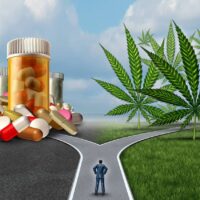
The UCLA Simms/Mann Center for Integrative Oncology, which has offered free psychosocial care for cancer patients and their families for 22 years, kicked off its 2015 “Insights into Cancer” lecture series with a panel on medicinal marijuana and cancer on January 13.
The panel featured two psychiatrists, Garth Terry and Thomas Strouse, and public policy professor Mark Kleiman, who was recently hired to develop an implementation scheme for the state of Washington’s legalized recreational marijuana.
It was a well attended event; however the issues addressed during the night (safety, addiction, withdrawal) didn’t always seem to match the concerns of the people in the audience dealing with cancer:
Terry, saying he was speaking his own opinions rather than UCLA’s, gave an overview of cannabis and the cannabinoids, with animated graphics that demonstrated the “feedback loop” by which endocannabinoids modulate that action of neurotransmitters like dopamine.
In 2010, Terry published an NIMH study using two CB1 inverse agonists labeled with a radioactive tracer to find receptors in the brain and body. His study found CB1 receptors in the cerebral cortex, basal ganglia, cerebellum and, surprisingly, in the brain stem. Formerly, Terry said, it was thought those receptors didn’t exist in the brain stem, which directs life-or-death processes like respiration. (I tried to ask Kleiman afterwards: wouldn’t cannabinoids there modulate the effect of other neurotransmitters, as they do elsewhere? but I didn’t get an answer.)
Terry presented graphs on IQ studies that show declines in IQ for people who smoke a great deal of pot, particularly if they do so before 18. The declines were reversible after 30 days’ absence, except for adolescent users. Terry said this fit with findings that cannabis users’ hippocampus volumes are lower, and that cortical measures of CB1 receptors are lower in cannabis users. After 30 days without cannabis, those receptors come back, but the hippocampus volume doesn’t.
Noting that cannabis-using drivers have a two-fold increase in accidents (without noting that alcohol and prescription drugs produce much greater numbers), Terry claimed studies show that regular users of cannabis drive more poorly after smoking than do non-users.
As to psychosis, the key age cut off is 25, Terry said. Studies on depression and cannabis have mixed results, he said, and revealed a prejudice when he mentioned the “well known” amotivational syndrome and “couch lock” associated with cannabis as perhaps playing into depression. Low doses of cannabis can alleviate anxiety, while higher ones can elevate it. On PTSD, the jury is still out, he said.
He then got into dependence, which he pegged at 9% in the general population and 17% for adolescent adopters; for daily users he said it was 50%. He noted that cannabis withdrawal is now in the Diagnostic and Statistical Manual (as is caffeine withdrawal, as of 2013). Lanny Swerdlow asked in the Q&A if some of the “withdrawal symptoms” listed (anxiousness, etc.) might be symptoms the person was having before trying cannabis, and so it wouldn’t be surprising that those symptoms would return upon ceasing treatment with cannabis. Terry agreed that was one possibility.
Variability of supply and receptor differences in people are problematic, Terry said, as are unknown drug interactions and contaminants. The variability question was addressed in the Q&A afterwards by Dr. Allen Frankel, who, after identifying himself as having trained at UCLA, said “dose-consistent THC and CBD by the milligram” is available. Kleiman questioned the lab tests, particularly because the growers or the dispensaries generally pay for them. Frankel replied that he tests medicine himself.
Dr. Strouse then took to the stage to discuss the benefits of medical marijuana for cancer patients. He started with the 1999 IOM report, which he called “revolutionary” in that it acknowledged 4000 years of cannabis use. He noted that the LA Times that morning had written a story about a federal judge who was reconsidering marijuana’s Schedule I status (http://www.latimes.com/local/politics/la-me-marijuana-lsd-heroin-controlled-substances-act-20150113-story.html#page=1).
The best clinical research, he said, was done in 2000 in California. He called Donald Abrams’s study on pot smoking and neuropathic pain “groundbreaking” and said the average 34% pain reduction it found would be enough to win FDA approval for any drug. He noted that neuropathic pain is common in diabetes and HIV patients, and that chemotherapy can induce it as well. He also mentioned the 2013 Wilsey study on vaporized, low-dose cannabis for pain, and like Terry noted that therapeutic doses can be lower than psychoactive ones.
After also presenting Johnson’s 2010 study on Sativex in the “leading” Journal of Pain Management, which also found that the oral THC:CBD spray helped patients step down from opioids (“which might be a good thing”) and lessened sleeplessness and nausea, Strouse concluded there is “credible evidence that cannabis is helpful for neuropathic pain.”
Marinol, Strouse noted, was studied for pain, but the side effects outweighed the benefit. He noted that no head-to-head trials have compared cannabis with prescription medications for pain, or for nausea, for which the benefits of cannabis are “old news,” he said.
Noting that Big Money has come into the marijuana industry in recent days, Strouse ended with the question, will Big Marijuana safeguard the public health, or will it act like Big Tobacco did?
Kleiman took the stage with the statement, “Those of you applauding [positive statements about marijuana] can get ready to hiss.” But his presentation ping-ponged back and forth between positive and negative statements about marijuana, pandering for laughs but occasionally providing an interesting perspective.
He claimed marijuana can’t be a medicine because it isn’t a single chemical, but noted the irony that the FDA has approved the chemical (THC) they call most dangerous. He jokingly called marijuana “a completely benign drug that sends half a million people to the emergency room every year” and got the crowd gasping with the story of Maureen Dowd’s candy bar malfunction, told in harrowing detail.
But then he pooh-poohed the IQ study presented, summing it up as “people smoking heavily before they were 14, and continuing to do so for 35 years, are a little dumber.” He did worry that daily use is up 7% and trotted out his usual tirade about 85% of the pot sold going to people who use it three times a day (citing a Beau Kilmer/RAND study), without adding that heavy users account for the same percentage of alcohol and just about everything else sold.
Kleiman said the word “Privateer” (the company that has just invested in Leafly) can be defined as “government-licensed piracy” and put on screen the Leafly ad that ran in the NYTimes, noting that it deceptively made cannabis strains look like they came from the Periodic Chart (meaning they would be molecules, not whole plants). He harkened to the Kush Doctor on Venice Beach, and Zonker of Doonesbury, and claimed that most cannabis recommendations are written for “pain or anything else.”
He then said he wouldn’t be surprised if whole-plant extract proved to be more effective than Sativex or THC for pain. Stressing that it wasn’t the Schedule I status but rather the monopoly of UMiss and NIDA’s rules, said, “We must break that monopoly…Every 14-year-old boy has better access to cannabis than do researchers and that’s got to change.
Although the doctors on the panel noted that they were not oncologists, the subject of Rick Simpson Oil / Phoenix Tears a possible cancer cure was brought up during the Q&A. Strouse ventured that although there is some animal and in vitro data to support an anti-cancer effect for cannabis, there are “no compelling trials” on large populations in humans. He advised her to talk to her cancer doctor before “playing with fire.”
Kleiman added that, since Tashkin found that cannabis smoke has more carcinogens than cigarette smoke, but has found no cancers caused by smoking cannabis, there is “surface plausibility” to the idea that there is something in cannabis that is anti-cancer.
One patient in the crowd who said she has treated her cancer with cannabis instead of chemo asked if the doctors would be willing to learn from her. They said yes. They were also asked if they be willing to study cannabis-using patients within the mandate of the Center, which for example leads groups on mindful meditation and spirituality, things traditionally aided by the use of marijuana.



